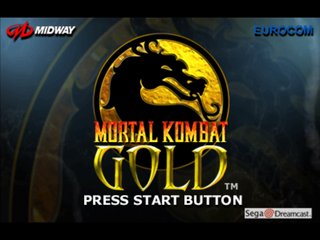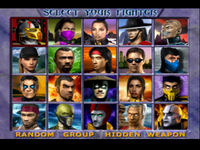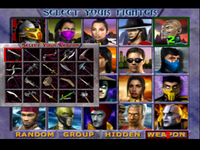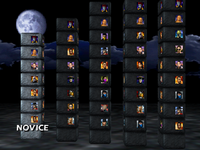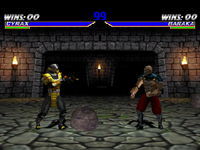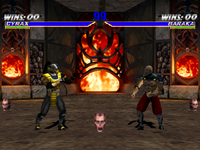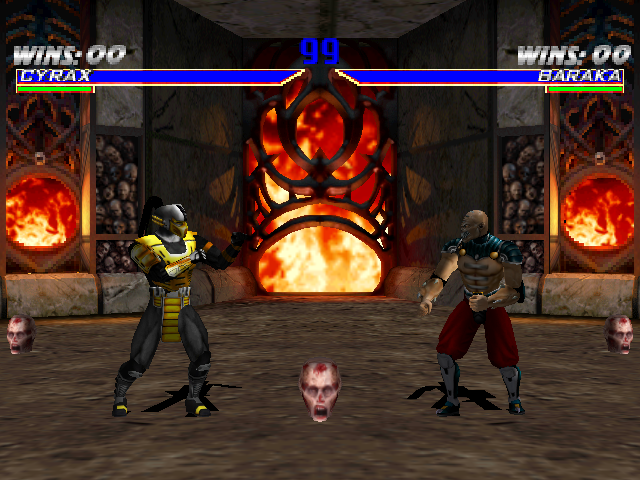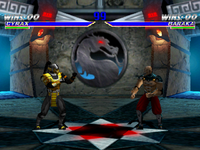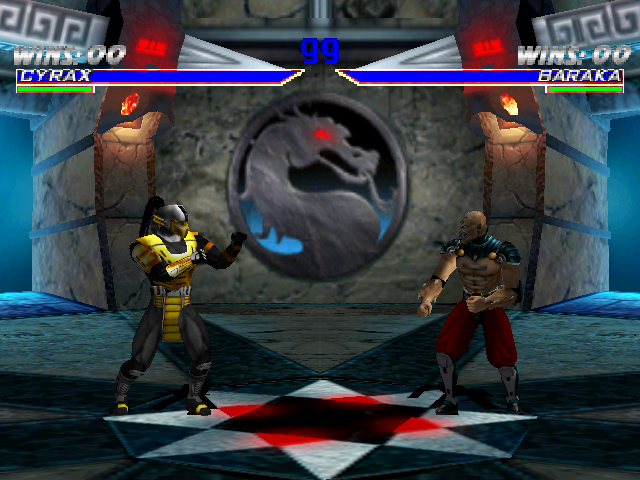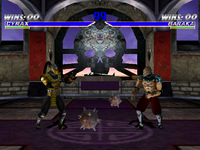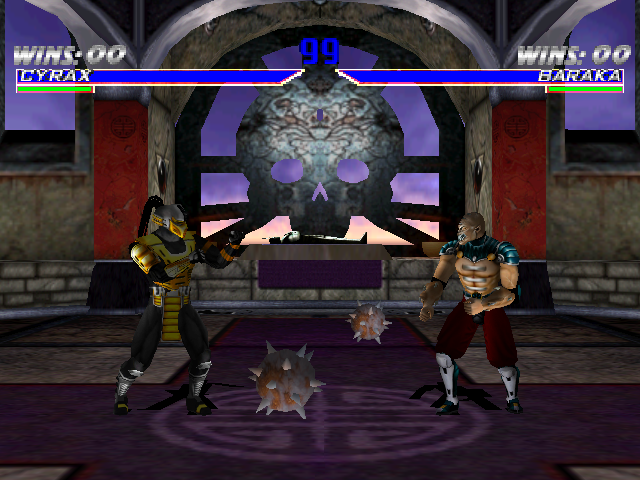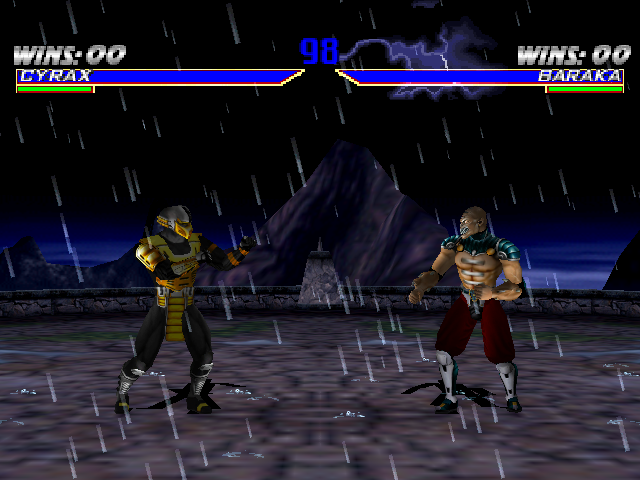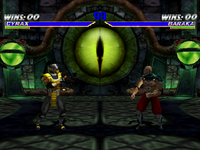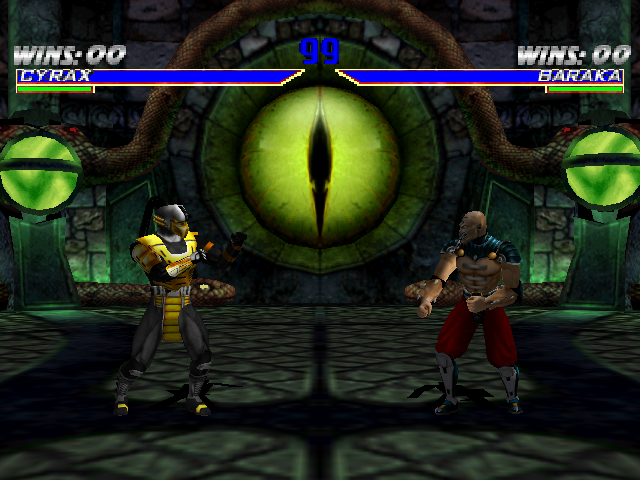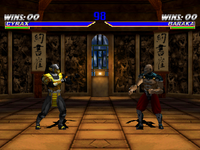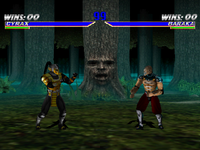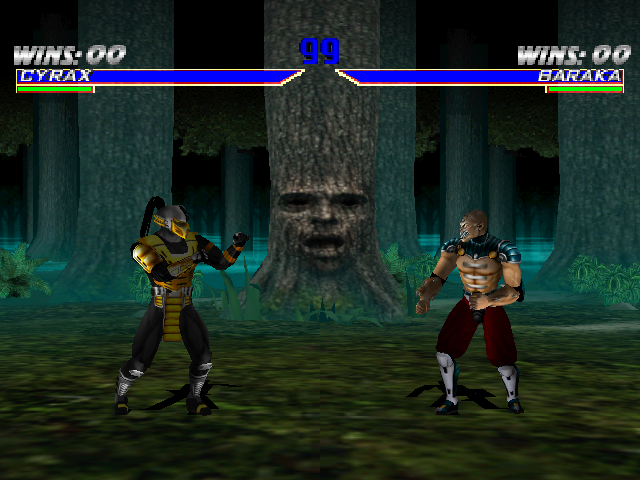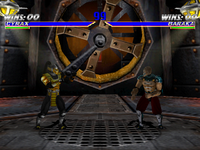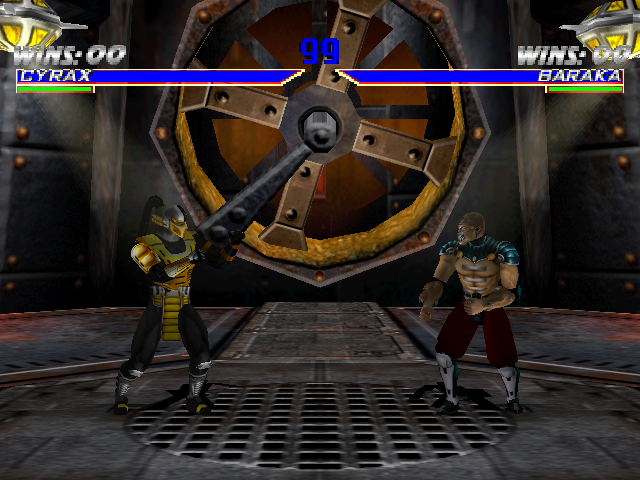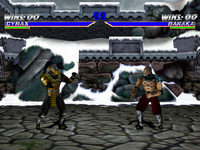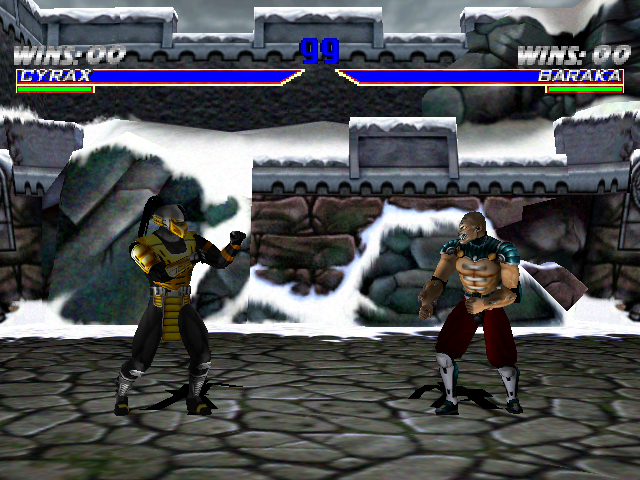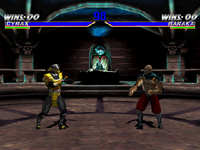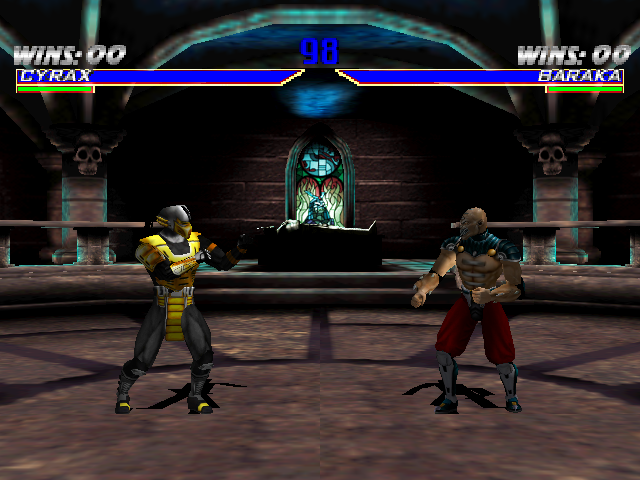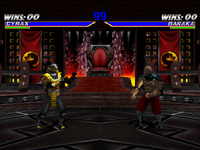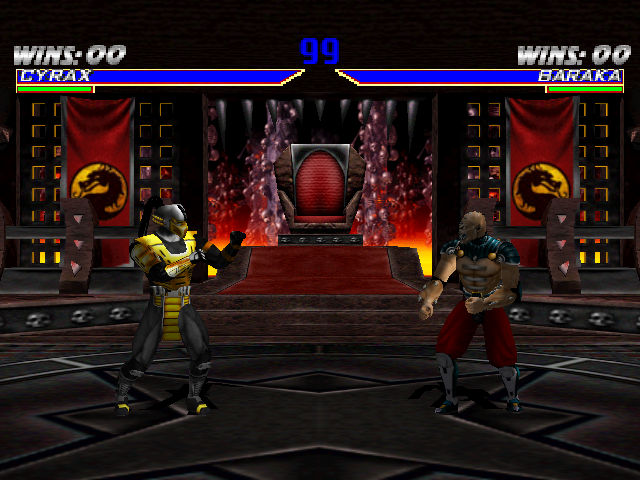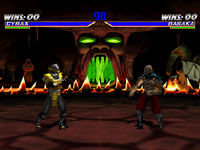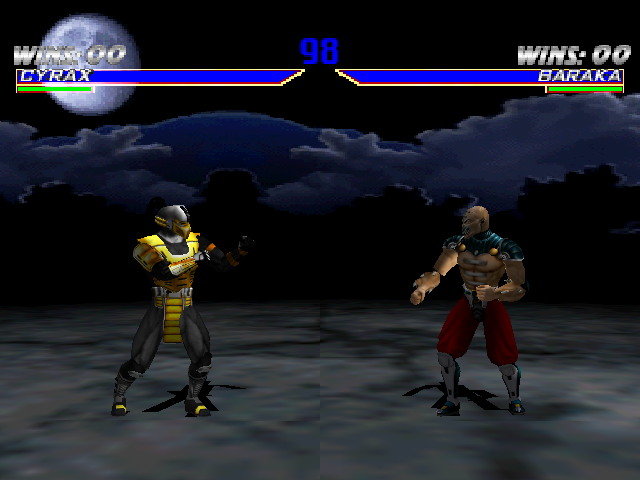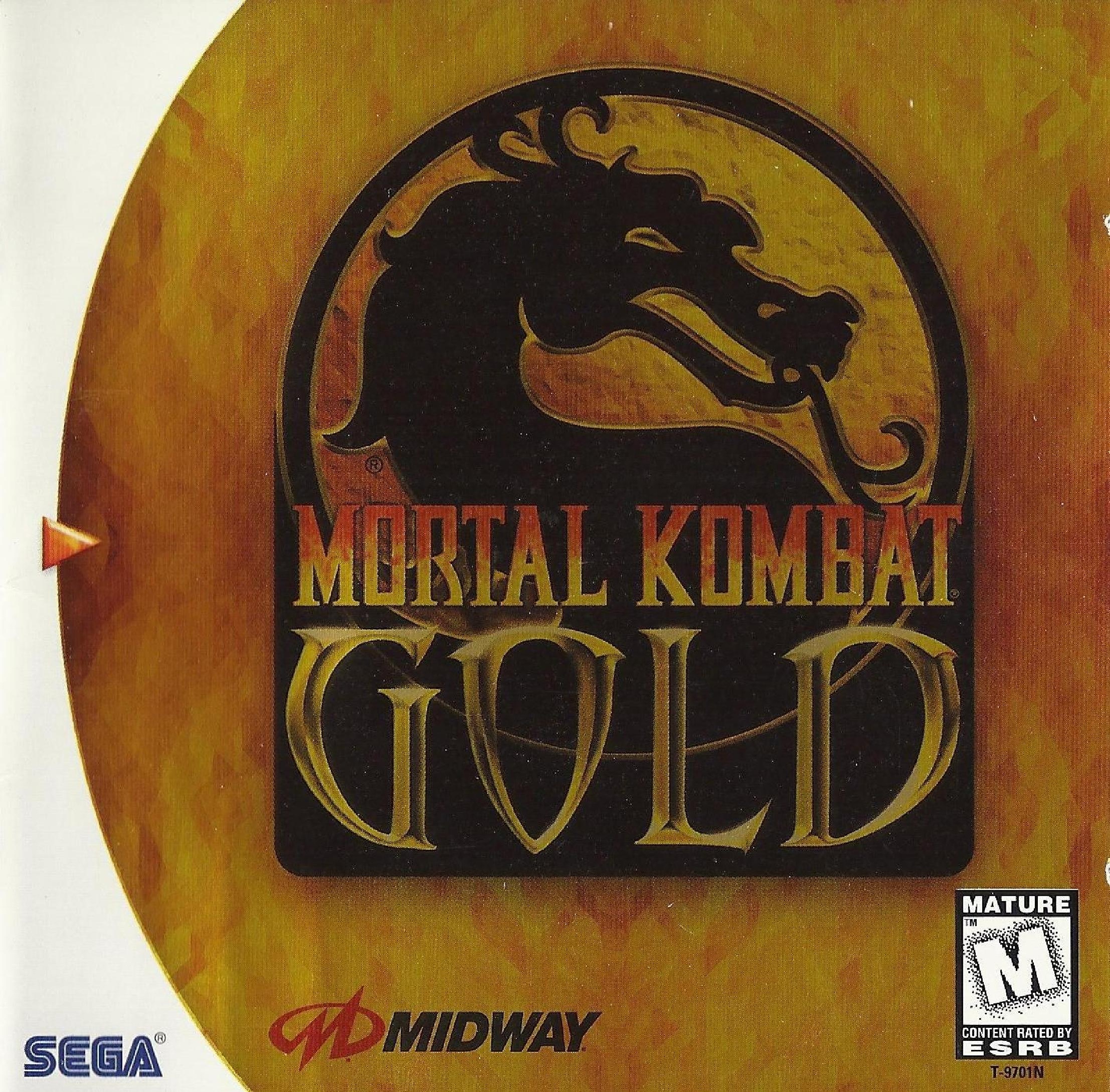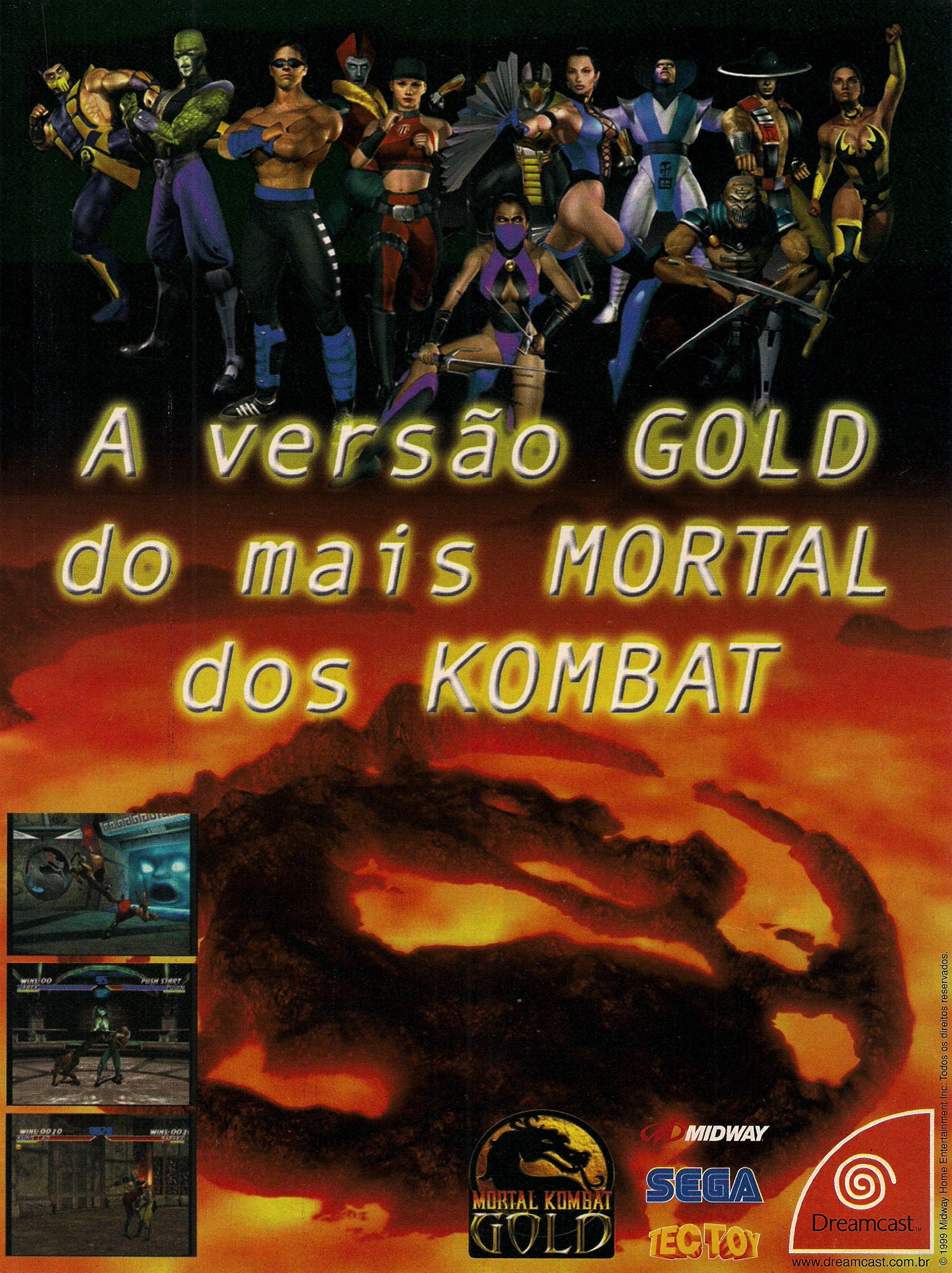Difference between revisions of "Mortal Kombat Gold"
From Sega Retro
(→Characters: MoveListNote template) |
|||
| (8 intermediate revisions by 3 users not shown) | |||
| Line 1: | Line 1: | ||
{{Bob | {{Bob | ||
| bobscreen=MortalKombatGold title.png | | bobscreen=MortalKombatGold title.png | ||
| + | | bobscreen2=MortalKombatGold DC US Title.png | ||
| + | | tab1=PAL | ||
| + | | tab2=NTSC-U | ||
| publisher=[[Midway Home Entertainment]] | | publisher=[[Midway Home Entertainment]] | ||
| developer={{company|[[Midway Games]]}} | | developer={{company|[[Midway Games]]}} | ||
{{company|[[Eurocom Entertainment Software]]|system=DC}} | {{company|[[Eurocom Entertainment Software]]|system=DC}} | ||
| + | | distributor={{company|[[Ecofilmes]]|region=PT}}, {{company|[[Metro Games]]|region=AU}}, {{company|[[Tec Toy]]|region=BR}} | ||
| system=[[Sega Dreamcast]] | | system=[[Sega Dreamcast]] | ||
| sounddriver= | | sounddriver= | ||
| Line 56: | Line 60: | ||
Characters move with {{left}} and {{right}} and crouch with {{down}}. They jump with {{up}} and jump back and forth with {{upleft}} and {{upright}}. All characters have punches and kicks that can either be aimed high or low. Characters perform a low punch with {{A}}, a high punch with {{X}}, a low kick with {{B}}, and a high kick with {{Y}}. Characters can sidestep to avoid projectiles by tapping {{R}}. They can run by holding {{R}}; they can only run forwards. The Run meter is drained both by running and by performing combos, but the meter replenishes quickly if not used for a second. Characters block by holding {{L}}. Blocking can be done while standing or crouching. Some attacks cannot be blocked while standing (such as sweeps). All attacks do a small amount of damage even when blocked. | Characters move with {{left}} and {{right}} and crouch with {{down}}. They jump with {{up}} and jump back and forth with {{upleft}} and {{upright}}. All characters have punches and kicks that can either be aimed high or low. Characters perform a low punch with {{A}}, a high punch with {{X}}, a low kick with {{B}}, and a high kick with {{Y}}. Characters can sidestep to avoid projectiles by tapping {{R}}. They can run by holding {{R}}; they can only run forwards. The Run meter is drained both by running and by performing combos, but the meter replenishes quickly if not used for a second. Characters block by holding {{L}}. Blocking can be done while standing or crouching. Some attacks cannot be blocked while standing (such as sweeps). All attacks do a small amount of damage even when blocked. | ||
| − | Each character is given a weapon that can be wielded with a button combination (specific to the character). Weapons are used with the punch buttons and offer increased reach and damage. | + | Each character is given a weapon that can be wielded with a button combination (specific to the character). Weapons are used with the punch buttons and offer increased reach and damage. Weapons are dropped when the character is knocked over or can be thrown at the opponent with a button combination. When a weapon is dropped, it can be picked up by either player by crouching over it and pressing {{R}}. Some stages contain objects such as rocks or severed heads that can be picked up and thrown in the same manner. |
In contrast to the multiple different types of finishing moves last seen in ''[[Mortal Kombat 3]]'' and its derivatives, the game pares finishing moves down to two Fatalities per character. As in previous entries, these finishing moves are performed using special button combinations after defeating the opponent in the last round of the match and kill the opponent in a particularly violent way. There are also two stage-specific Fatalities, in which a character is killed by being thrown into part of the stage. | In contrast to the multiple different types of finishing moves last seen in ''[[Mortal Kombat 3]]'' and its derivatives, the game pares finishing moves down to two Fatalities per character. As in previous entries, these finishing moves are performed using special button combinations after defeating the opponent in the last round of the match and kill the opponent in a particularly violent way. There are also two stage-specific Fatalities, in which a character is killed by being thrown into part of the stage. | ||
===Modes=== | ===Modes=== | ||
| + | {{ScreenThumb|Mortal Kombat Gold DC, Choose Your Destiny.png|width=200|Choose Your Destiny}} | ||
The game has the following modes: | The game has the following modes: | ||
*'''Arcade:''' There are two variations of this mode. In 1 on 1 Kombat, the player chooses one character and fights against one computer fighter per match. In 2 on 2 Kombat, the player chooses two characters and fights against two computer opponents per match. When the first character is defeated, the second character jumps into the battle with a full vitality bar. Both characters must be defeated in every round. In either mode, the player chooses a "tower" of opponents to face (Novice, Beginner, Warrior, Master, or Master II), with the more difficult towers having more opponents. The two bosses Goro and Shinnok await at the top of the towers. The game can only be continued a limited number of times if lost. A second player can challenge the first to a fight by pressing {{Start}} on a second control pad. After beating Shinnok with a character, that character's ending is unlocked for viewing in the Kombat Theater at any time (though the initial pressings of the game could not properly save the player's progress to a [[VMU]]). | *'''Arcade:''' There are two variations of this mode. In 1 on 1 Kombat, the player chooses one character and fights against one computer fighter per match. In 2 on 2 Kombat, the player chooses two characters and fights against two computer opponents per match. When the first character is defeated, the second character jumps into the battle with a full vitality bar. Both characters must be defeated in every round. In either mode, the player chooses a "tower" of opponents to face (Novice, Beginner, Warrior, Master, or Master II), with the more difficult towers having more opponents. The two bosses Goro and Shinnok await at the top of the towers. The game can only be continued a limited number of times if lost. A second player can challenge the first to a fight by pressing {{Start}} on a second control pad. After beating Shinnok with a character, that character's ending is unlocked for viewing in the Kombat Theater at any time (though the initial pressings of the game could not properly save the player's progress to a [[VMU]]). | ||
| Line 587: | Line 592: | ||
*'''Testers:''' Seher Basak, Nico Bihary, Weston Boucher, Aaron Orsak, Rick Waibel, Ray Veerkamp | *'''Testers:''' Seher Basak, Nico Bihary, Weston Boucher, Aaron Orsak, Rick Waibel, Ray Veerkamp | ||
*'''Product Manager:''' Derryl Depriest | *'''Product Manager:''' Derryl Depriest | ||
| − | *'''Special Thanks:''' Deborah Fulton, Ira Kalina, Kathy Lange, Kathy Schoback | + | *'''Special Thanks:''' Deborah Fulton, Ira Kalina, Kathy Lange, [[Kathy Schoback]] |
{{creditsheader|[[Eurocom]] Team}} | {{creditsheader|[[Eurocom]] Team}} | ||
*'''Project Management:''' Hugh Binns, Mark Hetherington, Tim Rogers | *'''Project Management:''' Hugh Binns, Mark Hetherington, Tim Rogers | ||
| Line 599: | Line 604: | ||
*'''Lead Quality Assurance:''' John Barker | *'''Lead Quality Assurance:''' John Barker | ||
*'''Quality Assurance:''' Michael Bothan, Andrew Walkner | *'''Quality Assurance:''' Michael Bothan, Andrew Walkner | ||
| − | *'''Special Thanks:''' Ed Boon, Dan Forden, Michael Gottlieb, Andy Kaffka, Gary Lake, David Michicich, Kevin Stainwright, John Tobias, Ed Tucker | + | *'''Special Thanks:''' Ed Boon, Dan Forden, Michael Gottlieb, Andy Kaffka, [[Gary Lake]], David Michicich, Kevin Stainwright, John Tobias, Ed Tucker |
| source=US manual | | source=US manual | ||
| pdf=MortalKombatGold DC US Manual.pdf | | pdf=MortalKombatGold DC US Manual.pdf | ||
| Line 666: | Line 671: | ||
| square=yes | | square=yes | ||
| disc=MKG DC EU Disc.jpg | | disc=MKG DC EU Disc.jpg | ||
| + | | manual=MortalKombat3Gold-DC-DEFRNL-Manual.pdf | ||
}}{{Scanbox | }}{{Scanbox | ||
| console=Dreamcast | | console=Dreamcast | ||
Latest revision as of 11:51, 20 November 2024
| |||||||||||||||||||||||||||||||||||||||||||||||||||||||
| Mortal Kombat Gold | |||||||||||||||||||||||||||||||||||||||||||||||||||||||
|---|---|---|---|---|---|---|---|---|---|---|---|---|---|---|---|---|---|---|---|---|---|---|---|---|---|---|---|---|---|---|---|---|---|---|---|---|---|---|---|---|---|---|---|---|---|---|---|---|---|---|---|---|---|---|---|
| System(s): Sega Dreamcast | |||||||||||||||||||||||||||||||||||||||||||||||||||||||
| Publisher: Midway Home Entertainment | |||||||||||||||||||||||||||||||||||||||||||||||||||||||
| Developer: Midway Games Eurocom Entertainment Software | |||||||||||||||||||||||||||||||||||||||||||||||||||||||
| Distributor: Ecofilmes (PT), Metro Games (AU), Tec Toy (BR) | |||||||||||||||||||||||||||||||||||||||||||||||||||||||
| Peripherals supported: Jump Pack | |||||||||||||||||||||||||||||||||||||||||||||||||||||||
| Genre: Action | |||||||||||||||||||||||||||||||||||||||||||||||||||||||
| Number of players: 1-2 | |||||||||||||||||||||||||||||||||||||||||||||||||||||||
|
Mortal Kombat Gold is a fighting game developed by Eurocom and published by Midway Home Entertainment. It was released exclusively on the Sega Dreamcast in 1999 as a launch title in North America and Europe. It is an updated version of the 1997 arcade game Mortal Kombat 4.
Contents
Story
Thousands of years ago, the Elder God known as Shinnok attempted to conquer all the realms of the universe. The thunder god Raiden fought and defeated Shinnok in a war that spanned hundreds of years, banishing him to the Netherealm, where he would be trapped forever. Now, Shinnok has managed to escape from the Netherealm with help from the sorcerer Quan Chi, and seeks vengeance against the Elder Gods who banished him. He first conquers the realm of Edenia with the aid of a traitor, Tanya, while he prepares to attack the Elder Gods. In order to stop Shinnok's menace, Raiden requests help from the Earthrealm warriors who saved the realms from Emperor Shao Kahn in previous titles.
Gameplay
Mortal Kombat 4 was the first 3D entry in the Mortal Kombat series, though it retains the 2D gameplay of the previous titles and plays similarly. As such, it is also the first game in the series to have polygonal characters with motion-captured animations rather than the digitized actors that the earlier games famously used. It introduced a limited weapon system, sidestepping, and several new characters. Mortal Kombat Gold adds six more characters (all returning from previous Mortal Kombat games) and three new stages. It also adds a weapon select system that allows the player to select a specific weapon from the character select screen before choosing a fighter (rather than using the character's default weapon).
Characters move with ![]() and
and ![]() and crouch with
and crouch with ![]() . They jump with
. They jump with ![]() and jump back and forth with
and jump back and forth with ![]() and
and ![]() . All characters have punches and kicks that can either be aimed high or low. Characters perform a low punch with
. All characters have punches and kicks that can either be aimed high or low. Characters perform a low punch with ![]() , a high punch with
, a high punch with ![]() , a low kick with
, a low kick with ![]() , and a high kick with
, and a high kick with ![]() . Characters can sidestep to avoid projectiles by tapping
. Characters can sidestep to avoid projectiles by tapping ![]() . They can run by holding
. They can run by holding ![]() ; they can only run forwards. The Run meter is drained both by running and by performing combos, but the meter replenishes quickly if not used for a second. Characters block by holding
; they can only run forwards. The Run meter is drained both by running and by performing combos, but the meter replenishes quickly if not used for a second. Characters block by holding ![]() . Blocking can be done while standing or crouching. Some attacks cannot be blocked while standing (such as sweeps). All attacks do a small amount of damage even when blocked.
. Blocking can be done while standing or crouching. Some attacks cannot be blocked while standing (such as sweeps). All attacks do a small amount of damage even when blocked.
Each character is given a weapon that can be wielded with a button combination (specific to the character). Weapons are used with the punch buttons and offer increased reach and damage. Weapons are dropped when the character is knocked over or can be thrown at the opponent with a button combination. When a weapon is dropped, it can be picked up by either player by crouching over it and pressing ![]() . Some stages contain objects such as rocks or severed heads that can be picked up and thrown in the same manner.
. Some stages contain objects such as rocks or severed heads that can be picked up and thrown in the same manner.
In contrast to the multiple different types of finishing moves last seen in Mortal Kombat 3 and its derivatives, the game pares finishing moves down to two Fatalities per character. As in previous entries, these finishing moves are performed using special button combinations after defeating the opponent in the last round of the match and kill the opponent in a particularly violent way. There are also two stage-specific Fatalities, in which a character is killed by being thrown into part of the stage.
Modes
The game has the following modes:
- Arcade: There are two variations of this mode. In 1 on 1 Kombat, the player chooses one character and fights against one computer fighter per match. In 2 on 2 Kombat, the player chooses two characters and fights against two computer opponents per match. When the first character is defeated, the second character jumps into the battle with a full vitality bar. Both characters must be defeated in every round. In either mode, the player chooses a "tower" of opponents to face (Novice, Beginner, Warrior, Master, or Master II), with the more difficult towers having more opponents. The two bosses Goro and Shinnok await at the top of the towers. The game can only be continued a limited number of times if lost. A second player can challenge the first to a fight by pressing START on a second control pad. After beating Shinnok with a character, that character's ending is unlocked for viewing in the Kombat Theater at any time (though the initial pressings of the game could not properly save the player's progress to a VMU).
- Team: A team battle mode that can be played by one player (versus the computer) or by two players. Both players form a team of one to five characters. Players start the first battle with their first characters. After a character is defeated in a match, that player plays as their next character in the next battle (while the other player continues with the same character), and so on until a player's entire roster has been eliminated.
- Endurance: A survival mode with three variations. In every variation, matches only consist of a single round and the player's vitality is never replenished. In Endurance, the player chooses any character and a tower and fights a series of opponents, similar to the Arcade mode. In Vs Endurance, two players fight each other playing as every character in the game (besides hidden characters) in a predetermined order. When one character is defeated, the player changes to the next character until one player has lost with every character. In Ultimate Endurance, the player chooses any character and fights a round against every character in the game.
- Tournament: A bracketed tournament that can be played with four fighters (with one to three human players) or eight fighters (with one to seven human players). The player can toggle whether to show the computer-versus-computer matches.
- Practice: A training mode. The player can choose both characters, set the opponent to inactive, active, or human-controlled, and play on any stage. The game shows the most recent button presses on the bottom of the screen. Both fighters have infinite vitality. The player can view a movelist for the current character by pausing the game with START . There is no ability to practice finishing moves.
The game has six difficulty settings for computer-controlled opponents (Very Easy, Easy, Medium, Hard, Very Hard, and Ultimate), and the player can also choose the number of rounds to win a match (between 2 and 9) and the number of continues for the single-player modes (between 0 and 9).
Characters
Note: Move lists assume that the character is facing right. When facing left, ![]() and
and ![]() should be reversed.
should be reversed.
| P | Any punch button |
| LP | Low punch |
| HP | High punch |
| K | Any kick button |
| LK | Low kick |
| HK | High kick |
| BL | Block |
| RN | Run |
All characters can perform roundhouse kicks with ![]() + HK (which knock the opponent across the screen), leg sweeps with
+ HK (which knock the opponent across the screen), leg sweeps with ![]() + LK (which cause the opponent to fall down), and uppercuts with
+ LK (which cause the opponent to fall down), and uppercuts with ![]() + HP (which knock the opponent high into the air). When standing next to an opponent, the character can do a throw with LP or do a "bonebreaker" move with LK .
+ HP (which knock the opponent high into the air). When standing next to an opponent, the character can do a throw with LP or do a "bonebreaker" move with LK .
Fatalities often require being a certain distance from the opponent in order to execute. There are two stage-specific Fatalities: the Fan Fatality for the Prison stage and the Spike Fatality for the Goro's Lair stage.
Playable
Sonya Blade, Jax Briggs, Liu Kang, Johnny Cage, Sub-Zero, Raiden, Scorpion, and Reptile return from previous Mortal Kombat games. Cyrax, Mileena, Kitana, Kung Lao, and Baraka are returning characters that were added exclusively to Mortal Kombat Gold.
Reiko, Jarek, Tanya, Kai, Shinnok, Fujin, and Quan Chi are new characters introduced in Mortal Kombat 4. Fujin and Quan Chi originally appeared in Mortal Kombat Mythologies: Sub-Zero (which was only released for the PlayStation and Nintendo 64) but were not playable there.
Shinnok is the final boss character. Unlike bosses in previous games, he can be selected to play without the use of a cheat code.
Hidden
- Main article: Mortal Kombat Gold/Hidden content.
These characters can be played using cheat codes.
Goro appears in the single-player game as the sub-boss before Shinnok. He is exclusive to all of the home ports of Mortal Kombat 4. Sektor is exclusive to Mortal Kombat Gold.
Goro and Noob Saibot have unknown button combinations for their Fatalities (or possibly no button combinations), but they can be performed using the one-button Fatality cheat code.
In addition to these characters, there is a cheat code to use a bloody skeleton model called "Meat" (used for some of the Fatalities) with any character, retaining the moves of the chosen character. Meat would become a full character later in the series.
| Goro | |||||||||||||||||||||||||||||||||
|---|---|---|---|---|---|---|---|---|---|---|---|---|---|---|---|---|---|---|---|---|---|---|---|---|---|---|---|---|---|---|---|---|---|
A half-human, half-dragon who once served Shang Tsung and now seeks revenge against Liu Kang for his defeat in the original Mortal Kombat. He is the sub-boss of the game.
| |||||||||||||||||||||||||||||||||
| Sektor | |||||||||||||||||||||||||||||||||
Unit LK-9T9, the first of three prototype cybernetic ninjas built by the Lin Kuei. He is given orders to watch and report on Cyrax.
| |||||||||||||||||||||||||||||||||
| Noob Saibot | |||||||||||||||||||||||||||||||||
A Lin Kuei assassin who serves as one of Shinnok's generals.
|
Stages
Stages are chosen randomly. Goro is always fought in Goro's Lair, and Shinnok is always fought at the Well. Goro's Lair and the Prison have stage-specific Fatalities.
The Church, Netherealm, and Soul Chamber stages were newly added to Mortal Kombat Gold. The hidden Ladder? stage, based on the background that appears during the Arcade mode towers, is also new and only accessible in two-player games using a Kombat Kode.
History
Development
An additional character named Belokk was shown in early screenshots from Game Informer but was cut from the final game.[10] According to Ed Boon, Belokk was cut due to time constraints.[11]
Release
The game was criticised upon release for its subpar graphics. Rather than play to the Dreamcast's strengths, the game was said to look more like the Nintendo 64 port of Mortal Kombat 4.
Like several of Midway's Dreamcast games, the game was re-released with a "Hot! New!" label in North America, fixing many of the game's bugs (including VMU support, allowing the player to save; the manual for the initial pressing of the game warns players not to enable memory saving in the game's options). As well as the label, the game can be identified by its red-tinted disc.
Versions
The game retains the improvements from the other home ports of Mortal Kombat 4, including the addition of Goro as a sub-boss. It includes the prerendered full-motion video endings from the PlayStation version (the arcade and Nintendo 64 versions use in-engine cutscenes).
Production credits
- Mortal Kombat was created by: Ed Boon, John Tobias
- Mortal Kombat Gold Design Team: Ed Boon, Dave Michicich, Todd Allen, Mike Boon, Steve Beran, John Vogel, Tony Goskie, Dan Forden, John Tobias, Josh Tsui, Mark Loffredo, Mark Penacho, Herman Sanchez
- Executive Producers: Neil Nicastro, Ken Fedesna, Paul Dussault, Cary Mednick
- Game Analysts/Testers: Paulo Garcia, Eddie Ferrier, Mike Vinikour, Alex Gilliam
- Very Special Thanks: Tamara Michicich, Eydie Boon, Heather Boon, Mercedes Moncion, Ed Keenan, David Behr, Sal DiVita, Jim Tianis, Sara Rose, Art Tianis, Ellen Galassini, Jim Gentile, Kevin Day, Matt Booty, Mark Turmell, Dimitrios Tianis, Sean Scanlon, Jason Scanlon
- Producer: Michael Gottlieb
- Associate Producer: Andy Kaffka
- Assistant Producer: Ed Tucker
- Technical Director: Scott Maxwell
- Print Design & Production: Midway Creative Services, San Diego, CA
- Test Manager: Rob Sablan
- Lead Tester: Sunny Chu
- Testers: Seher Basak, Nico Bihary, Weston Boucher, Aaron Orsak, Rick Waibel, Ray Veerkamp
- Product Manager: Derryl Depriest
- Special Thanks: Deborah Fulton, Ira Kalina, Kathy Lange, Kathy Schoback
- Project Management: Hugh Binns, Mark Hetherington, Tim Rogers
- Lead Programming: Mark Hetherington
- Programming: Chris Jackson, Tim Rogers, Kevin Stainwright
- Tools Programming: Chris Jackson, Kevin Marks, Andy Mitchell
- Additional Programming: Rob Watkins, Ian Denny, Tim Rogers
- Home Game Enhancements: Bill Beacham, Ken Harvey
- Textures, Art, & Animation: Andy Bee, Nigel Bently, Colin Garrat, Darren Hyland
- Music and Sound: Neil Baldwin, Guy Cockcroft
- Lead Quality Assurance: John Barker
- Quality Assurance: Michael Bothan, Andrew Walkner
- Special Thanks: Ed Boon, Dan Forden, Michael Gottlieb, Andy Kaffka, Gary Lake, David Michicich, Kevin Stainwright, John Tobias, Ed Tucker
Magazine articles
- Main article: Mortal Kombat Gold/Magazine articles.
Promotional material
Physical scans
| Sega Retro Average | |||||||||||||||||||||||||||||||||||||||||||||||||||||||||||||||||||||||||||||||||||||||||||||||||||
|---|---|---|---|---|---|---|---|---|---|---|---|---|---|---|---|---|---|---|---|---|---|---|---|---|---|---|---|---|---|---|---|---|---|---|---|---|---|---|---|---|---|---|---|---|---|---|---|---|---|---|---|---|---|---|---|---|---|---|---|---|---|---|---|---|---|---|---|---|---|---|---|---|---|---|---|---|---|---|---|---|---|---|---|---|---|---|---|---|---|---|---|---|---|---|---|---|---|---|---|
|
| 57 | |
|---|---|
| Based on 19 reviews | |
| Dreamcast, DE/FR/NL |
|---|
Technical information
- Main article: Mortal Kombat Gold/Technical information.
ROM dump status
| System | Hash | Size | Build Date | Source | Comments | |||||||||
|---|---|---|---|---|---|---|---|---|---|---|---|---|---|---|
| ? |
|
GD-ROM (US) | ||||||||||||
| ? |
|
GD-ROM (US) | ||||||||||||
| ? |
|
GD-ROM (EU) | ||||||||||||
| ? |
|
1999-08-28 | GD-R | Page |
External links
- Sega of America webpage: Dreamcast
References
- ↑ Press release: 1999-09-02: Sega Dreamcast Launch Titles and Peripherals
- ↑ http://www.sega.com:80/sega/catalog/SegaProduct.jhtml?PRODID=243 (Wayback Machine: 2001-12-06 19:10)
- ↑ http://www.chipsworld.co.uk/DetProd.asp?ProductCode=1187 (Wayback Machine: 2002-09-17 14:23)
- ↑ https://groups.google.com/g/uk.games.video.dreamcast/c/x1G_lWU6GLc/m/gfKmBOkejE4J
- ↑ 5.0 5.1 Dreamcast Magazine, "No. 3" (UK; 1999-11-25), page 54
- ↑ 6.0 6.1 Official Dreamcast Magazine, "November 1999" (UK; 1999-09-30), page 96
- ↑ 7.0 7.1 Revista Oficial Dreamcast, "Enero 2000" (ES; 1999-12-20), page 43
- ↑ http://www.futuregamez.net:80/outnow/dc.html (Wayback Machine: 2001-07-31 23:17)
- ↑ Hyper, "December 1999" (AU; 1999-xx-xx), page 62
- ↑ http://www.gamespot.com/articles/mortal-kombat-gold-interview/1100-2450709/ (Wayback Machine: 2014-02-19 18:50)
- ↑ http://www.mortalkombatonline.com/content/kom/transcripts/EdBoon_08-25-1999.html (Wayback Machine: 2004-02-18 19:45)
- ↑ File:MortalKombatGold DC US Manual.pdf, page 35
- ↑ Ação Games, "Novembro 1999" (BR; 1999-xx-xx), page 30
- ↑ Arcade, "December 1999" (UK; 1999-11-01), page 101
- ↑ Consoles +, "Novembre 1999" (FR; 1999-1x-xx), page 170
- ↑ DC-UK, "December 1999" (UK; 1999-11-22), page 38
- ↑ Dreamcast: Le Magazine Officiel, "Décembre 1999/Janvier 2000" (FR; 1999-12-xx), page 102
- ↑ Dreamzone, "Decembre 1999" (FR; 1999-11-16), page 118
- ↑ Electronic Gaming Monthly, "October 1999" (US; 1999-09-07), page 220
- ↑ Entsiklopediya igr dlya Dreamcast, "Izdaniye chetvertoye, dopolnennoye" (RU; 2002-xx-xx), page 135
- ↑ GameFan, "Volume 7, Issue 10: October 1999" (US; 1999-xx-xx), page 20
- ↑ GamePro, "October 1999" (US; 1999-xx-xx), page 138
- ↑ GamesMaster, "Christmas 1999" (UK; 1999-11-29), page 71
- ↑ Game Informer, "October 1999" (US; 1999-xx-xx), page 69
- ↑ Man!ak, "Grudzień 1999" (PL; 1999-xx-xx), page 75
- ↑ Neo Plus, "Grudzień 1999" (PL; 1999-xx-xx), page 30
- ↑ Next Generation, "October 1999" (US; 1999-09-21), page 108
- ↑ Player One, "Novembre 1999" (FR; 1999-xx-xx), page 100
| Mortal Kombat Gold | |
|---|---|
|
Main page | Comparisons | Hidden content | Development | Magazine articles | Reception | Bootlegs
Prototypes: 1999-08-28
| |
| Mortal Kombat games for Sega systems | |
|---|---|
| Mortal Kombat (?) | Mortal Kombat II (?) | Mortal Kombat 3 (1995) | Ultimate Mortal Kombat 3 (1996) | |
| Mortal Kombat (1993) | Mortal Kombat II (1994) | Mortal Kombat 3 (1996) | |
| Mortal Kombat (?) | |
| Mortal Kombat II (?) | |
| Mortal Kombat II (?) | Mortal Kombat 3 (unreleased) | Ultimate Mortal Kombat 3 (1996) | Mortal Kombat Trilogy (1997) | |
| Mortal Kombat Gold (1999) | |
| Unlicensed Mortal Kombat games for Sega systems | |
| Mortal Kombat 5 (1999) | |
- Jump Pack-compatible games
- 1-2 player games
- US Dreamcast games
- All US games
- DE Dreamcast games
- All DE games
- ES Dreamcast games
- All ES games
- FR Dreamcast games
- All FR games
- PT Dreamcast games
- All PT games
- UK Dreamcast games
- All UK games
- DE/FR/NL Dreamcast games
- All DE/FR/NL games
- ES/UK/IT Dreamcast games
- All ES/UK/IT games
- AU Dreamcast games
- All AU games
- BR Dreamcast games
- All BR games
- Dreamcast games
- 1999 Dreamcast games
- All 1999 games
- Dreamcast action games
- All action games
- Dreamcast games with Sofdec video
- All games
- Missing ROM hashes
- Games with known prototypes
- Old technical information
- Mortal Kombat Gold
- Mortal Kombat (franchise)

